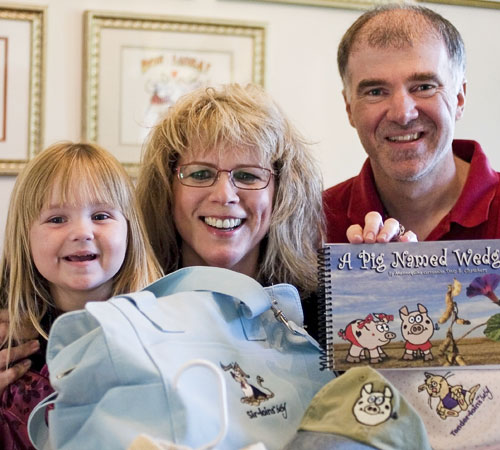Local artist draws first 3-D, rural comic strip

Champaign residents Don Chambers and Laura Chambers pose with their daughter Ariana at their home on Thursday. Erica Magda
September 24, 2008
Small-town comic strip illustrator Don Chambers, who grew up spending his free time attempting to draw characters from “Peanuts” and “Beetle Bailey,” knows that the careers of many great comic writer-illustrators had rocky starts. Charles Schulz, for instance, supported himself by teaching and sold his first cartoons to small newspapers before Peanuts became a syndicated comic strip.
Chambers works from his Champaign home, which he shares with his wife, Laura, and his daughter, Ariana, to whom his latest project, a children’s book, is dedicated. On display on their living room wall is a collection of personalized comics drawn especially for Don and Laura by famous comic strip writers – pieces from Dik Browne, creator of “Hagar the Horrible,” and Jerry Scott and Jim Borgman, authors of “Zits.”
Don’s workspace is his living room table, or more specifically, his laptop, where he does most of his drawing using design software.
His comic strip, “Mannequins,” was the first newspaper comic to feature three-dimensional characters against backgrounds of real photos in each frame. “Mannequins” has been published weekly in the Arthur Graphic-Clarion in Arthur, Illinois since 1996.
“I get my ideas just from living: listening, reading, watching the news,” Don said. “There’s sometimes continuity of storylines and themes, but usually each [comic strip] is just its own thing.”
Get The Daily Illini in your inbox!
Don uses a software program called Poser to draw 3-D images of characters; he then scans textiles and other materials to obtain images of various textures for the characters’ clothing.
Don and Laura’s main focus is currently on promoting Don’s first children’s book, “A Pig Named Wedge,” which he hopes to turn into a series, as well as the clothing line that sprung from that book. Their products include a starter set of baby clothing for new moms.
“The clothing line is an attempt at cross-promotion with the books,” Laura said.
The story is set against simple rural photographic backdrops, placing the whimsical illustrations of farm animals – dressed in human clothes – in landscapes that feel familiar.
Laura and Don want the characters to become iconic, like Charles Schulz’s Snoopy and Charlie Brown. In his next book, Don hopes to craft for each character – such as Wedge, the pig, and Cameo, the butterfly – a fully formed, distinct personality.
“I am working, with Laura and our wonderful interns, to further develop the personalities and individual quirks of each character,” Don said.
Chamber’s comic-making interns are also dedicated to helping him flesh out his characters.
“We’re trying to promote … Wedge as a character, as an image,” Jill Novak, junior in Media, said. Novak is one of three interns for The Mannequins Studios, the Chambers’ company. “We want people to recognize the image in order to promote the book. We’re hoping that kids will relate to Wedge and his struggle to find his purpose.”
Don is also working on a compilation of “Mannequins” comic strips to celebrate the series’ twelfth year.
For the comic’s backgrounds, Don uses an archive of photos he collected from several photo-taking sprees in Illinois and Indiana.
His first book, “Mannequins: At Home in Illinois and Western Indiana,” which Don self-published in 2001, follows the “Mannequins” characters through dozens of small towns. The backgrounds for the stories may seem arbitrary, as the characters’ dramas rarely include reference to specific locales, though the photos place the narratives in a small-town, rural setting.
“Many of my readers have mentioned to me that they enjoy guessing where the characters are while they are speaking,” Don said. “No other cartoonist I’ve met is willing to personalize the comic, if desired, for their individual town by including photos of it from time to time.”
The storyline sometimes dictates what photo Don chooses to use; other times the photos serve simply as interesting aesthetic backdrops, Don said.
In his second “Mannequins” book, “Mannequins Rocks Southern England and the Midwestern United States,” Don used several photos he took on vacation in England.
Despite receiving recognition for his work – his animations and graphics have been used in four award-winning PBS documentaries – Don has yet to see The Mannequins Studios become a profitable enterprise.
The company sometimes makes small sales; a few books and clothing items here or there, but Don and Laura hope to find a publisher to buy their products in bulk.
“I know if we keep trying . eventually we will find someone or some company with the foresight and vision to realize how hungry we are to make good things happen,” Don said. “We’ve tapped a market of social and rural humor, funny but with a good heart, which is currently only being served by comedians such as Jeff Foxworthy and Larry the Cable Guy. With their success, ours is only a matter of time as well.”






